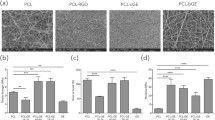Abstract
Fibrin has been used extensively in cell encapsulation because it has important biological properties. Keratinocyte encapsulation in fibrin is a widely used technique in skin tissue engineering. The production of growth factors (EGF, TGF-β1 and PDGF-BB) was evaluated when keratinocytes are encapsulated in fibrin. Secretions of TGF-β1 and PDGF-BB increased more than five times compared to monolayer cultures. Encapsulated cells secreted about 80% active form of TGF-β1 (monolayer cells only secreted inactive form). An enhanced secretion of TGF-β1 and PDGF-BB was found in encapsulated cells, showing that fibrin capsules are favourable for the production of these growth factors.






Similar content being viewed by others
References
Acevedo CA, Weinstein-Oppenheimer C, Brown DI, Huebner H, Buchholz R, Young ME (2009a) A mathematical model for the design of fibrin microcapsules with skin cells. Bioprocess Biosyst Eng 32:341–351
Acevedo CA, Brown DI, Young ME, Reyes JG (2009b) Senescent cultures of human dermal fibroblasts modified phenotype when immobilized in fibrin polymer. J Biomater Sci Polym Ed 20:1929–1942
Barrientos S, Stojadinovic O, Golinko MS, Brem H, Tomic-Canic M (2008) Growth factors and cytokines in wound healing. Wound Rep Reg 16:585–601
Cartmell S (2009) Controlled release scaffolds for bone tissue engineering. J Pharm Sci 98(2):430–441
Chen CP, Yang YC, Su TH, Chen CY, Aplin JD (2005) Hypoxia and transforming growth factor-beta 1 act independently to increase extracellular matrix production by placental fibroblasts. J Clin Endocrinol Metab 90(2):1083–1090
Cox S, Cole M, Tawil B (2004) Behavior of human dermal fibroblast in three-dimensional fibrin clots: dependence on fibrinogen and thrombin concentration. Tissue Eng 10(5):942–954
Eyrich D, Gopferich A, Blunk T (2006) Fibrin in tissue engineering. Adv Exp Med Biol 585:379–392
Falabella A, Falanga V (2001) Wound healing. In: Freinkel RK, Woodley DT (eds) The biology of the skin. Parthenon Publishing, New York, pp 281–297
Horch RE, Bannasch H, Stark GB (1999) Cultured human keratinocytes as a single cell suspension in fibrin glue combined with preserved dermal grafts enhance skin reconstitution in athymic mice full-thickness wounds. Eur J Plast Surg 22:237–243
Horch RE, Bannasch H, Stark GB (2001) Transplantation of cultured autologous keratinocytes in fibrin sealant biomatrix to resurface chronic wounds. Transplant Proc 33:642–644
Jiao X, Kopp J, Tanczos E, Voigt M, Stark G (1998) Culture keratinocytes suspended in fibrin glue to cover full thickness wounds on athymic nude mice: comparison of two brands of fibrin glue. Eur J Plast Surg 21:72
Karel S, Libicki S, Robertson C (1985) The immobilization of whole cells: engineering principles. Chem Eng Sc 40(8):1321–1354
Kim S, Yu S, Son J, Huebner H, Buchholz R (1998) Calculations on O2 transfer in capsules with animal cell for the determination of maximum capsule size without O2 limitation. Biotechnol Lett 20:549–552
Kourembanas S, Hannan R, Faller D (1990) Oxygen tension regulates the expression of the platelet-derived growth factor beta chain gene in human endothelial cells. J Clin Invest 86:670–674
Mazlyzam AL, Aminuddin BS, Fuzina NH, Norhayati MM, Fauziah O, Isa MR, Saim L, Ruszymah BHI (2007) Reconstruction of living bilayer human skin equivalent utilizing human fibrin as a scaffold. Burns 33:355–363
Niesler CU, Ferguson MWJ (2001) TGFB superfamily cytokines in wound healing. In: Breit SM, Wahl SM (eds) TGFB and related cytokines in inflammation. Basel, Switzerland, pp 173–198
Orive G, Hernández RM, Gascón AR, Calafiore R, Chang TMS, De Vos P, Hortelano G, Hunkeler D, Lacík I, Shapiro J, Pedraz JL (2003) Cell encapsulation: promise and progress. Nat Med 9:104–107
Park H, Temenoff JS, Tabata Y, Caplan AI, Mikos AG (2007) Injectable biodegradable hydrogel composites for rabbit marrow mesenchymal stem cell and growth factor delivery for cartilage tissue engineering. Biomaterials 28:3217–3227
Poole IC, Boyce ST (1999) Keratinocytes suppress transforming growth factor-β1 expression by fibroblasts in cultured skin substitutes. Br J Dermatol 140:409–416
Schmidt JJ, Rowley J, Kong HJ (2008) Hydrogels used for cell-based drug delivery. J Biomed Mater Res A 87(4):1113–1122
Acknowledgment
The authors wish to thank CONICYT by FONDEF Grant (D07I1075) and doctoral fellowships for R.A. Somoza.
Author information
Authors and Affiliations
Corresponding author
Rights and permissions
About this article
Cite this article
Acevedo, C.A., Somoza, R.A., Weinstein-Oppenheimer, C. et al. Growth factor production from fibrin-encapsulated human keratinocytes. Biotechnol Lett 32, 1011–1017 (2010). https://doi.org/10.1007/s10529-010-0245-5
Received:
Revised:
Accepted:
Published:
Issue Date:
DOI: https://doi.org/10.1007/s10529-010-0245-5




